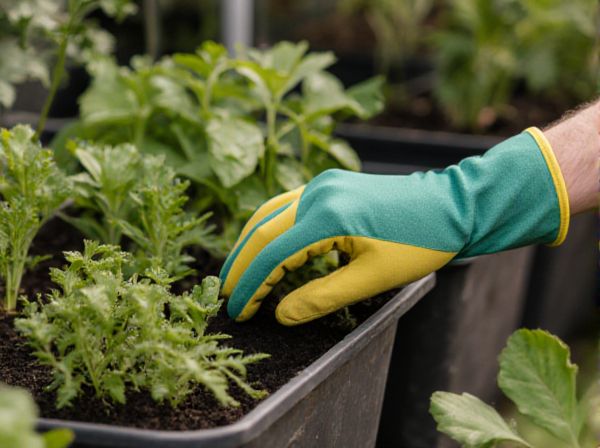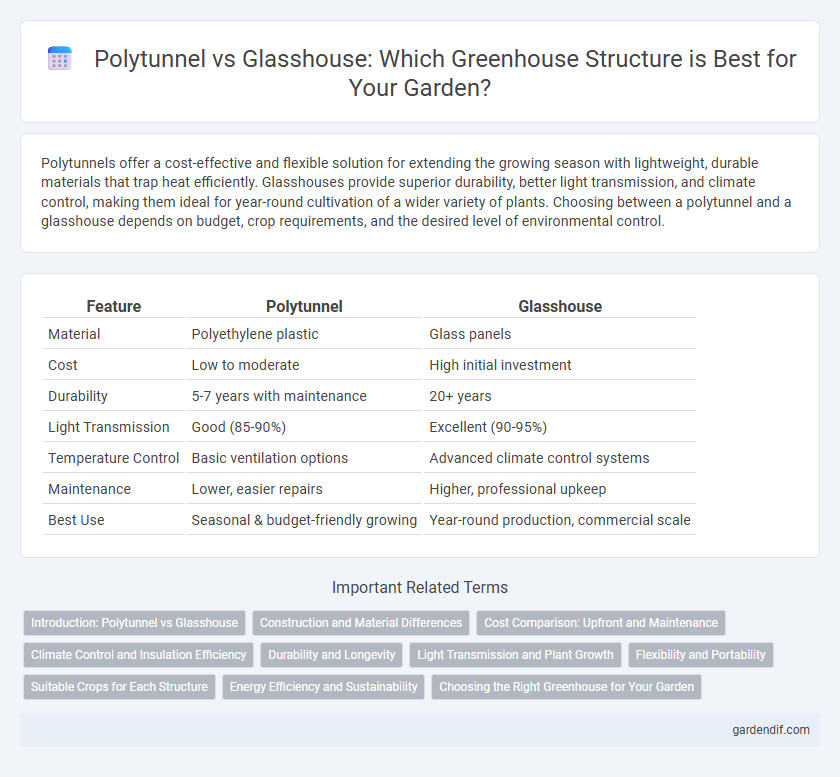
Polytunnel vs Glasshouse Illustration
Polytunnels offer a cost-effective and flexible solution for extending the growing season with lightweight, durable materials that trap heat efficiently. Glasshouses provide superior durability, better light transmission, and climate control, making them ideal for year-round cultivation of a wider variety of plants. Choosing between a polytunnel and a glasshouse depends on budget, crop requirements, and the desired level of environmental control.
Table of Comparison
| Feature | Polytunnel | Glasshouse |
|---|---|---|
| Material | Polyethylene plastic | Glass panels |
| Cost | Low to moderate | High initial investment |
| Durability | 5-7 years with maintenance | 20+ years |
| Light Transmission | Good (85-90%) | Excellent (90-95%) |
| Temperature Control | Basic ventilation options | Advanced climate control systems |
| Maintenance | Lower, easier repairs | Higher, professional upkeep |
| Best Use | Seasonal & budget-friendly growing | Year-round production, commercial scale |
Introduction: Polytunnel vs Glasshouse
Polytunnels and glasshouses are essential structures for controlled-environment agriculture, each offering distinct advantages for crop production. Polytunnels provide cost-effective, flexible covering using polyethylene plastic, promoting rapid heat retention and protection from pests and weather, making them ideal for seasonal and commercial growers. Glasshouses utilize rigid glass panels allowing maximum sunlight transmission and controlled ventilation systems, supporting year-round cultivation of high-value crops with precise climate regulation.
Construction and Material Differences
Polytunnels are constructed using a lightweight metal frame covered with polyethylene plastic, making them cost-effective and flexible for various shapes and sizes, while glasshouses use rigid aluminum or steel frames with glass panels for durability and better light transmission. Polytunnels generally provide less insulation and have shorter lifespans due to the plastic covering, whereas glasshouses offer superior climate control, longevity, and protection from external weather elements. The choice between polytunnel and glasshouse depends on budget, crop requirements, and long-term investment in structural integrity.
Cost Comparison: Upfront and Maintenance
Polytunnels generally have a lower upfront cost compared to glasshouses, making them an economical choice for small-scale and seasonal growers. Maintenance expenses for polytunnels tend to be higher over time due to the need for regular replacement of plastic covers, which can degrade under UV exposure. Glasshouses require a significant initial investment but benefit from durability and lower long-term maintenance costs, as glass panels last longer and need less frequent replacement.
Climate Control and Insulation Efficiency
Polytunnels offer flexible climate control with polyethylene covers that retain heat efficiently, making them ideal for extending growing seasons in moderate climates. Glasshouses provide superior insulation due to their rigid glass panels, ensuring stable temperature regulation and optimal light diffusion for year-round cultivation. The choice between polytunnel and glasshouse largely depends on the need for precise environmental control versus cost-effective insulation.
Durability and Longevity
Polytunnels offer high durability due to their flexible, weather-resistant polyethylene covers, which can last up to 7-10 years with proper maintenance. Glasshouses, constructed with rigid glass panels and sturdy metal frameworks, typically provide superior longevity, often exceeding 20 years when maintained well. While polytunnels are more susceptible to damage from strong winds or hail, glasshouses resist these elements better, making them a longer-term investment for greenhouse cultivation.
Light Transmission and Plant Growth
Polytunnels provide approximately 70-90% light transmission, creating a diffused light environment that reduces plant stress and promotes uniform growth, whereas glasshouses offer higher light transmission levels, often exceeding 90%, enhancing photosynthesis and boosting crop yield. The diffused sunlight in polytunnels minimizes leaf scorch and supports stronger root development, while the clear glass structure allows maximum natural light, benefiting light-loving crops during critical growth stages. Choosing between polytunnels and glasshouses depends on crop type, desired light intensity, and climate conditions to optimize plant growth and energy efficiency.
Flexibility and Portability
Polytunnels offer greater flexibility and portability compared to glasshouses due to their lightweight polyethylene covers and modular frames, allowing easy relocation and resizing. Glasshouses, constructed with rigid glass panels and permanent aluminum or steel frames, provide less adaptability for space changes and are more difficult to move. This makes polytunnels ideal for seasonal crops and temporary setups, while glasshouses are better suited for stable, long-term horticultural environments.
Suitable Crops for Each Structure
Polytunnels excel in growing heat-loving and fast-maturing crops such as tomatoes, peppers, cucumbers, and strawberries due to their superior heat retention and ventilation control. Glasshouses are ideal for delicate and high-value crops like orchids, citrus fruits, and exotic plants, offering enhanced light diffusion and durability. Understanding crop requirements and local climate helps determine the best choice between polytunnel and glasshouse structures.
Energy Efficiency and Sustainability
Polytunnels offer superior energy efficiency by utilizing lightweight polyethylene covers that retain heat and reduce energy consumption compared to traditional glasshouses with heavier, less insulating glass panels. Their lower initial energy requirements contribute to sustainability by minimizing greenhouse gas emissions during heating cycles. Additionally, polytunnels often allow for natural ventilation and solar gain adjustments, enhancing eco-friendly growing conditions while reducing reliance on artificial climate control systems.
Choosing the Right Greenhouse for Your Garden
Polytunnels offer a cost-effective and flexible option for extending the growing season, providing enhanced protection against wind and pests with their durable polyethylene covers. Glasshouses, constructed with rigid glass panels and aluminum or wooden frames, deliver superior light transmission and long-term durability, making them ideal for year-round cultivation of a wide range of plants. When choosing the right greenhouse, consider factors such as budget, climate, plant types, and available space to ensure optimal growth and maintenance.
Polytunnel vs Glasshouse Infographic

 gardendif.com
gardendif.com